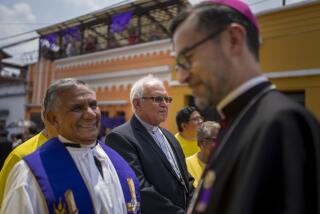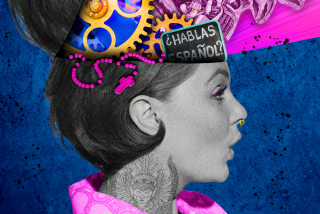The soul of colonial Quito
Jesus came to Quito with a heavy military escort, nine brass bands and a crown of thorns made of barbed wire.
It was Good Friday in Ecuador’s capital, and I was standing on a stepstool I had borrowed from a shopkeeper, straining to see over the crowd of umbrella-wielding tourists who lined the Plaza San Francisco for the traditional procession of penitents.
In a little more than an hour, I counted 19 versions of Jesus, several trembling beneath crosses made of beams nearly the size of telephone poles. Around them marched other penitents, most clad in purple hoods and robes, some flagellating themselves with rope. I thought them pretty worthy of forgiveness.
Fernando Torres, the owner of my stepstool, did not.
“There’s little faith,” he told me, standing at the door of his tiny shop. “The ones carrying the heaviest crosses are the same ones that will be passed out drunk tomorrow.” As the crowd dispersed, I had to agree that this was a possibility. Because although Quito boasts a perpetually spring-like climate, a stunning physical setting and debatably the best colonial architecture in all of South America, it is still a place pulsing with Third World life, with all its attendant chaos, grit and sin.
In the tourism world, Quito is often seen as a stopover on the way to the Galápagos Islands, Ecuador’s best-known tourist attraction. The tourists who spend significant amounts of time in the city tend to be young backpackers, a demographic that may appreciate modern Quito’s nightlife more than the colonial section’s magnificent architecture.
That’s a shame, because Quito is a fascinating and beautiful place.
Situated in a narrow valley less than 15 miles south of the equator, Quito has an Andean elevation — about 9,300 feet — that means that daily high temperatures average in the 60s and low 70s year-round. The city can still get chilly, especially during storms in the October-to-May rainy season, but the weather is usually so perfect that most homes do not have air-conditioning or heating.
The city, however, is vulnerable to earthquakes, and it sits at the base of the Guagua Pichincha volcano. Although the volcano is relatively quiet now, it has spewed ash several times since 1999. Luckily, the crater angles away from Quito, offering some protection from anything more than ash falls and mudslides.
Modern Quito’s history began in 1534, when the Spanish conquistadors marched into the city only to discover that a retreating Inca general had razed it. Undaunted, the Spaniards began work on the San Francisco church and monastery only weeks after their arrival.
In the ensuing centuries, Quito became a city dominated by Catholic religious fervor, a spiritual and artistic center that produced a series of gold-gilded churches decorated by the artists of the Quito School, a distinguished tradition that incorporated indigenous elements into European styles.
In 1978, the United Nations Educational, Scientific and Cultural Organization named the city’s colonial sector a world cultural heritage site, and its many churches and colonial buildings are remarkably well maintained to this day.
Appreciation and precaution
Quito is really two cities: the modern, glass-and-concrete north and the chaotic, working-class south. Colonial Quito is very much a part of this second area, and many of its streets still doubled as crowded, open-air markets during my visit last April.An ongoing urban renewal project has since moved the street vendors to centralized markets, attracted new restaurants and imposed some order, but old Quito retains its gritty flavor and a sprinkling of pickpockets, locals say. The U.S. State Department agrees, warning travelers to be alert because of street crime and an increase of violent and nonviolent crime throughout the nation. With a little caution, however, the area’s working-class atmosphere can actually add a dimension to its appeal: Unlike cathedrals in largely secular Europe, Quito’s churches are used as much for worship as for tourism.
This became evident to me on the Thursday before Easter, when I read a sign informing me that La Compañía de Jesús, often considered the city’s most important and ornate church, was off-limits to tourists until after the holidays. By then, I would be leaving.
Determined to visit, I nervously eyed the guard standing at the church’s doorway. Then, I sheepishly approached and asked whether I could enter the church if I were attending a Mass.
Sure, he said, pressing his hands together in a praying motion. Just go in and pray for a while. Then you’re not a tourist, right?
Savoring this triumph of Ecuadorian logic, I took off my hat and walked through the church’s simple wooden door, attempting to convey an air of reverence. Then I looked up and gasped.
Nearly the entire inside of the church was covered in gold. From the twisted, Solomonic columns behind the altar to the Moorish ornamentation of the ceiling, the entire building seemed to glow.
I slid into a pew, prayed for several minutes, and then opened my eyes and sat, taking in the splendor of a building that, according to legend, required seven tons of gold to build.
Humble people, ornate churches
LA Compañía is probably the most jaw-dropping of colonial Quito’s more than 30 churches, but others have their own allures. A few blocks downhill from La Compañía is Santo Domingo, with colorful murals and beautiful domes. It is illuminated in the evening for added effect.Uphill sits La Merced, my favorite church because of its early 20th century paintings, which depict Mary or Jesus watching over the political events, earthquakes and eruptions that have marked Quito’s history.
For a completely different sort of experience, you can check out La Basílica, colonial Quito’s newest church. Set on the northern fringe of the colonial area and covered with stone gargoyles, this church appears stuck in a perpetual state of almost-completion.
Its interior is not terribly interesting, but the building’s unfinished state — combined with Ecuador’s apparent lack of personal injury lawsuits — has converted its towers into a sort of ecclesiastical playground in the sky.
I discovered this after the Good Friday procession of penitents, when a blustery Englishman named Ed joined me in walking a catwalk across the top of the nave, then climbing a rickety ladder to the base of a rear tower.
I ascended the ladders leading to the tower’s top, scampering between the side of the tower and the empty air. Someone had strapped chicken wire to the rungs, and I hoped that this would hold if I slipped, preventing me from pinwheeling hundreds of feet to my death.
After taking in the view and descending, I returned to the other end of the church and scaled a series of steep ladders to the belfry, an ascent that everyone seems to commemorate by ringing the church’s four bells. I celebrated by drinking a $1 beer in the tower’s cafeteria, which has one of the best views of the colonial city that I can imagine.
The most venerable of the city’s churches, however, is the monastery of San Francisco. as well as an attached museum of religious art. There, I strolled past a series of sculptures and paintings by members of the Quito School, including a darkly fascinating series of paintings depicting the seven deadly sins.
The altar of the church includes the Virgin of Quito, a winged virgin sculpted in the 18th century by Bernardo de Legarda, a master of the Quito School. A greatly enlarged version of this statue sits atop the Panecillo, the hill that overlooks all of colonial Quito. Made of 7,000 pieces of aluminum, it is the world’s largest aluminum sculpture, at least according to one local guide.
Walking to the top of the Panecillo, however, is generally considered the city’s quickest way to get mugged. Taking a taxi is much safer.
In all, I spent a week in Quito, visiting churches and museums, walking narrow cobblestone streets and lounging in the modern city’s stylish Internet cafes.
Even then, I felt that there was much I hadn’t seen, more museums, more churches, more restaurants and nightclubs. Part of the problem, I knew, was simply that there was so much to see.
But I had also been hindered by the rainy season’s afternoon thunderstorms, which often forced me into a cafe, where I drank a cup of coffee and usually lost motivation. In fact, it was one such storm that ran me into another church, El Sagrario, for the Easter Mass.
I entered the church, cold and dripping, and slid into a hard wooden pew. Like most of Quito’s churches, El Sagrario features beautiful, gold-covered side chapels that contrast with its creaky wooden floor. Overall, though, I was wet and cold and not feeling particularly receptive to beauty.
Then something remarkable happened.
The service started, and a soprano began singing “He arose! He arose!” in soaring Spanish that resonated across the gold leaf and the painted columns. Groups of drenched families began to trickle inside, gnarled grandmothers next to fresh-scrubbed children. It then occurred to me that the most remarkable contrast in old Quito is between the gaudy richness of the city’s churches and the quiet humility of the poor people who worship there.
I pondered this while the soprano — performing as part of a program that brings Ecuadorian and international musicians into churches during the Easter season — finished singing, and the priest began preaching.
While thunder cracked and the rain fell, he spoke of the need to focus on things of the spirit, and not on things of the world.
Good advice, I thought. But in a place like colonial Quito, with its poverty and riches, chaos and grandeur, the physical world is hard to ignore.
*
(BEGIN TEXT OF INFOBOX)
The way to Quito
GETTING THERE:
From LAX, connecting service (change of planes) is available to Quito on American, Continental, Lan Chile and COPA airlines. Restricted round-trip fares begin at $970 until April 11 and then are $920 until June 14.
TELEPHONES:
To call the numbers below from the U.S., dial 011 (the international dialing code), 593 (country code for Ecuador), 2 (city code for Quito) and the local number.
CURRENCY:
ATM machines can be found everywhere, and the U.S. dollar is Ecuador’s official currency.
WHERE TO STAY:
Lodging is available at prices ranging from $1.50 per night to hundreds of dollars. Most of the better hotels are in the northern part of town.
Posada del Maple, E8-49 Juan Rodriguez and 6 de Diciembre; 237-375, https://www.posadadelmaple.com . This bed-and-breakfast hostel has a quiet location and attractive patio. Doubles begin at $26.
Café Cultura, 513 Robles and Reina Victoria, Quito; 255-8858, https://www.cafecultura.com . This is my favorite Quito hotel. Once the French Cultural Center, the building was carefully restored and each room is a painted work of art. Doubles begin at about $77 and there are peacocks roaming the grounds. Ask to see the rooms so you can choose the one you want.
Hilton Colón Quito, Avenidas Patria and Amazonas, Quito; 256-0666 or 1-800-HILTONS (445-8667) in the U.S., fax 256-3903, https://www.quito.hilton.com . This is Quito’s best-known option, with a casino, travel agency and other amenities. Doubles start at $75.
Hotel Real Audiencia, Bolívar 220 and Guayaquil, Quito; 295-2711, fax 258-0213, https://www.realaudiencia.com . If you want to stay in colonial Quito, the best choice is the Hotel Real Audiencia. Its cafe has views of the Panecillo hill and the Santo Domingo church, which is especially pretty at night when the domes are lighted. Doubles begin at $45.
WHERE TO EAT:
The Mariscal Sucre district is full of good places to eat, with options ranging from sushi to Mongolian barbecue.
Café Cultura (address above) has fabulous breakfasts and a sunny courtyard. Entrees are $4-$9.
Mamá Clorinda, 114 Reina Victoria and Calama; 254-2523. The building is unattractive, but the food is good and reasonably priced. Entrees are $3.50-$7.
El Cafecito, 1124 Luis Cordero and Reina Victoria; 223-4862. Good vegetarian food and a bohemian, candlelit ambience. Most entrees are less than $5.
La Cueva del Oso, 1046 Chile and Venezuela; 258-3826. This is a classy lodging near the Plaza de la Independencia in colonial Quito. Entrees range from $6 to $9.
Gárgola Cafeteria, La Basílica church, Venezuela and Carchi. No phone. For sandwiches, coffee, snacks and one of the best views in town, check out this cafeteria in the tower of La Basílica, where everything on the menu is less than $1.50, and if you’re foolhardy, you can drink $1 beers until you have the courage to climb a series of ladders into the belfry.
TO LEARN MORE:
Ecuador’s Tourism Ministry has a helpful website, https://www.vivecuador.com but no U.S. office. Tourist information may also be obtained through the Ecuadorian embassy, 2535 15th St., N.W., Washington, D.C. 20009; (202) 234-7200, https://www.ecuador.org . An independent website, https://www.ecuadorexplorer.com , has lots of great information.
— Ben Brazil
More to Read
Sign up for Essential California
The most important California stories and recommendations in your inbox every morning.
You may occasionally receive promotional content from the Los Angeles Times.










